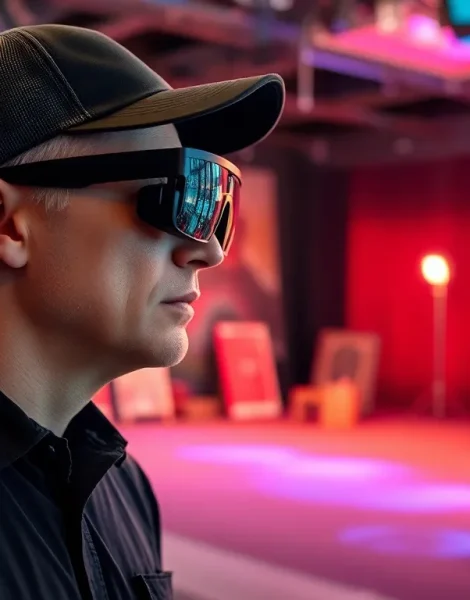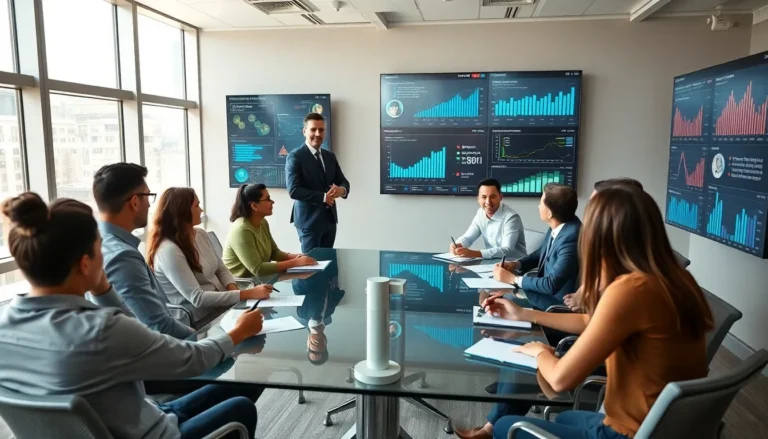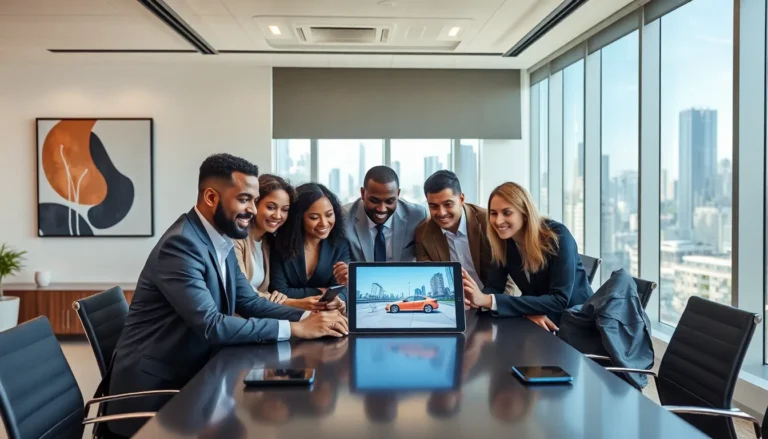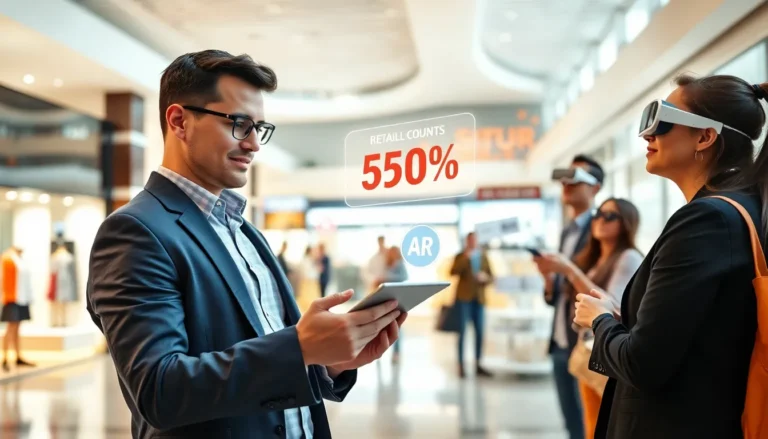Imagine stepping onto a film set where the lines between reality and imagination blur like a poorly mixed cocktail. That’s the magic of augmented reality (AR) in film production. It’s not just for sci-fi flicks anymore; AR has become the secret sauce that spices up storytelling, making it more immersive and engaging than ever before.
Table of Contents
ToggleOverview of AR Technology
Augmented reality (AR) technology integrates digital elements into the user’s real-world view, enhancing visual experiences. AR uses devices such as smartphones, tablets, and specialized glasses to overlay computer-generated imagery onto live video feeds. This capability allows filmmakers to blend virtual environments with actual locations, making scenes more dynamic and captivating.
Many studios adopt AR for pre-visualization, enabling directors and cinematographers to experiment with shots in real time. This practice aids in planning complex scenes, saving time and resources during the filming process. With AR tools, creators can visualize special effects before shooting, streamlining the production workflow.
AR also plays a significant role during post-production. By using AR applications, editors can review and alter scenes more effectively, fine-tuning visual elements. However, the benefits extend beyond production; marketing teams utilize AR for promotional materials, creating interactive trailers and experiences that attract audiences.
Industry leaders report increased engagement with films incorporating AR elements. Audiences enjoy interactive experiences that invite participation, fostering a deeper connection with the story. Furthermore, as AR technology advances, filmmakers discover new possibilities for storytelling.
In the future, AR is likely to further redefine film production methods. Its potential impacts include seamless integration of storytelling and viewer interaction, making films more immersive than ever. Overall, AR technology stands as a pivotal advancement within the film industry, creating fresh opportunities for creativity and audience engagement.
Impact of AR in Film Production
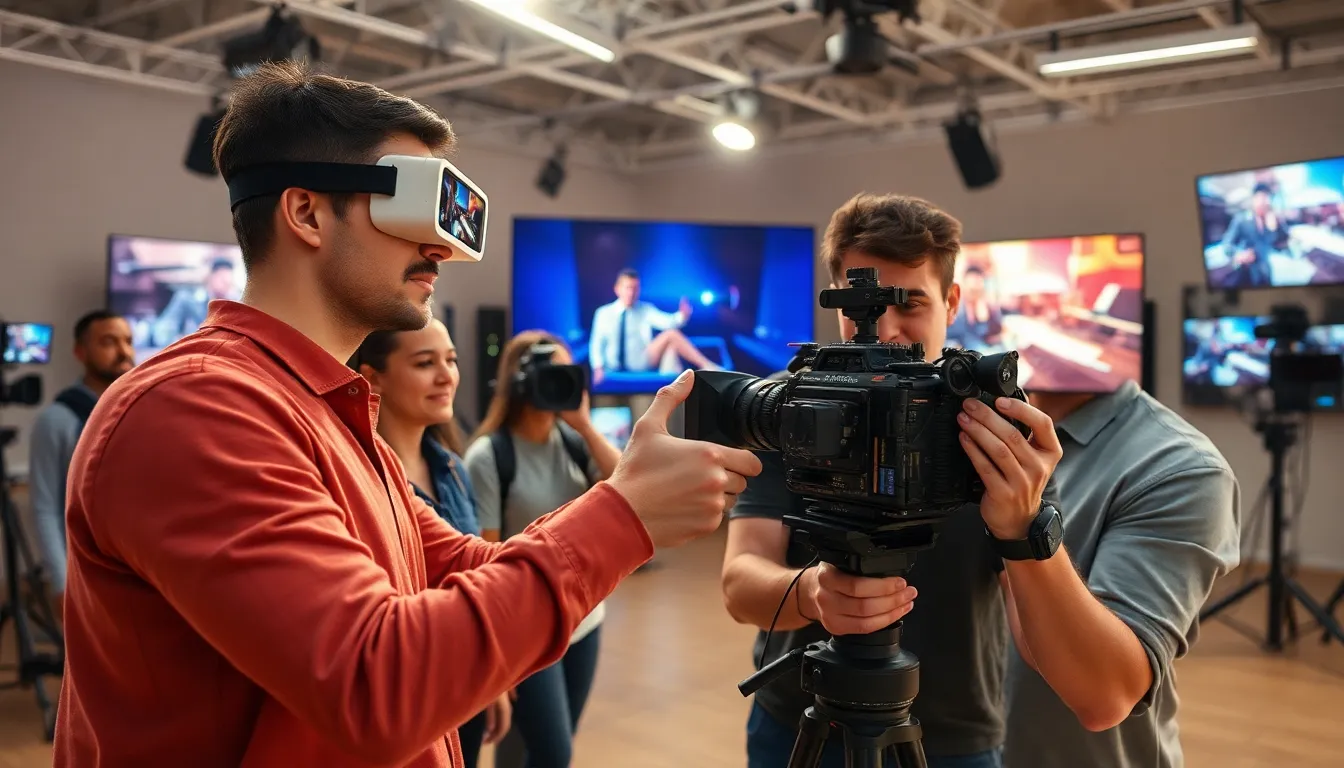
Augmented reality (AR) significantly transforms film production by enhancing storytelling and creating immersive experiences. Filmmakers integrate AR technology to engage audiences, making the viewing experience more dynamic.
Enhancing Storytelling
AR enriches narratives through interactive elements. Viewers encounter stories in real-world contexts, deepening emotional connections. Integration of digital components allows filmmakers to visualize complex plots where scenes unfold around the audience. Directors utilize this technology to provide viewers with alternate perspectives, offering layers of meaning that traditional methods can’t achieve. With the use of AR, storytelling becomes more versatile, enabling the blend of fiction and reality. Visual storytelling now encompasses a broader range of experiences, captivating audiences beyond the screen.
Creating Immersive Experiences
Immersion stands at the forefront of AR’s impact on film. Through interactive technologies, audiences participate in the narrative, heightening engagement levels. Filmmakers utilize AR tools to produce rich environments where viewers interact with characters and settings. These environments not only enhance the narrative but also create memorable moments that resonate with audiences. By layering digital imagery over actual scenes, filmmakers bring spaces to life, inviting viewers to explore the story world. AR fosters a sense of presence, allowing spectators to feel part of the film, rather than just passive observers.
Applications of AR in Film Production
Augmented reality (AR) has numerous applications in film production that enhance creativity and efficiency across various stages of filmmaking. From pre-production to post-production, AR significantly alters how filmmakers approach their craft.
Pre-Production Planning
Pre-production planning benefits immensely from AR technology. Filmmakers use AR for storyboarding, allowing teams to visualize scenes before shooting begins. This method helps identify potential challenges early. Teams can also create interactive prototypes of sets and environments, enabling better collaboration among directors, cinematographers, and production designers. These tools promote more informed decision-making and streamline the planning process.
On-Set Visualization
On-set visualization represents a crucial application of AR in film production. AR tools enable actors and crew to see virtual elements overlaid on real-world environments during filming. This capability assists in framing shots accurately while integrating special effects seamlessly. It supports directors in conveying their vision, allowing actors to interact with digital components naturally. Such innovative techniques contribute to more dynamic performances and a richer visual experience for the audience.
Post-Production Enhancements
Post-production enhancements greatly utilize AR to improve editing workflows. Editors can manipulate digital effects in real-time, simplifying the review process. This flexibility allows for quicker adjustments, making it easier to align visual effects with live-action footage. AR tools also enable the visualization of final sequences before they are rendered, ensuring that directors’ creative intentions stay intact. These advantages significantly accelerate the post-production timeline, supporting timely project releases.
Challenges of Implementing AR
Implementing augmented reality (AR) in film production presents several challenges that studios must navigate. Integration issues often arise as filmmakers try to blend digital elements with practical effects, leading to technical inconsistencies. Studios frequently face hardware limitations, which can affect the performance of AR applications, especially when relying on consumer-grade devices.
Budget constraints limit the ability to invest in high-quality AR technology and skilled personnel required for effective implementation. Training challenges emerge as crew members may need specialized knowledge to operate AR tools successfully. Many production teams encounter a steep learning curve, which can slow project timelines.
Collaboration between departments often suffers due to differing levels of familiarity with AR technology. Filmmakers might struggle to convey their vision effectively, and communication gaps can lead to misalignment on project goals. Furthermore, creative teams grapple with the risk of overusing AR elements, which may distract from the narrative instead of enhancing it.
Audience perception presents another complexity. Some viewers might not fully embrace AR experiences, preferring traditional storytelling methods. Filmmakers need to strike a balance between innovation and audience comfort. Additionally, technological advancements evolve rapidly; staying updated on the latest AR developments requires continuous investment and adaptation.
Privacy concerns are crucial as AR applications often rely on collecting user data for personalized experiences. Ensuring adherence to regulations while fostering viewer connection demands careful planning. Without addressing these challenges effectively, implementing AR in film production might hinder the creative potential that this technology brings.
Future Prospects of AR in Film Production
In the coming years, AR technology is expected to further revolutionize film production, offering new avenues for creativity. Enhanced immersion is likely to draw audiences into narratives, creating a more participatory viewing experience. Filmmakers might explore real-time interaction, allowing viewers to influence story outcomes or character decisions.
Data indicates that studios investing in AR have shown improved audience engagement. In addition to captivating stories, AR can create interactive marketing campaigns, elevating film visibility and attracting diverse demographics. This shift in marketing strategy could become standard practice as competition for viewer attention intensifies.
Creative storytelling techniques are also anticipated to evolve. Filmmakers could craft layered narratives where viewers explore various story paths through AR, fostering deeper connections with characters. This kind of engagement not only enhances the viewer’s emotional experience but also prolongs their investment in the film’s universe.
Collaboration among technology professionals and filmmakers may become more critical. Teams must harness AR’s potential while ensuring seamless integration with traditional filmmaking methods. Feedback loops in production workflows could also improve, as enhanced visualization technologies allow for real-time adjustments on set.
Challenges will always exist, including the balance between AR innovation and viewer comfort. Filmmakers need to remain attuned to audience preferences as they experiment with this technology. Addressing privacy concerns is essential, ensuring that user data is handled responsibly to maintain trust.
Overall, AR offers a promising future for film production, merging technology with artistry. As the industry adapts, embracing these innovations will be crucial for unlocking AR’s full potential, leading to novel cinematic experiences.
Augmented reality is reshaping the landscape of film production in remarkable ways. Its ability to enhance storytelling and foster viewer engagement marks a significant shift in how films are created and experienced. As filmmakers continue to explore innovative applications of AR technology, the potential for immersive narratives grows.
The integration of AR not only streamlines production processes but also invites audiences into the heart of the story. While challenges remain, such as technical integration and audience preferences, the future of AR in cinema looks bright. By merging creativity with cutting-edge technology, filmmakers are poised to deliver unforgettable experiences that redefine the art of storytelling.

